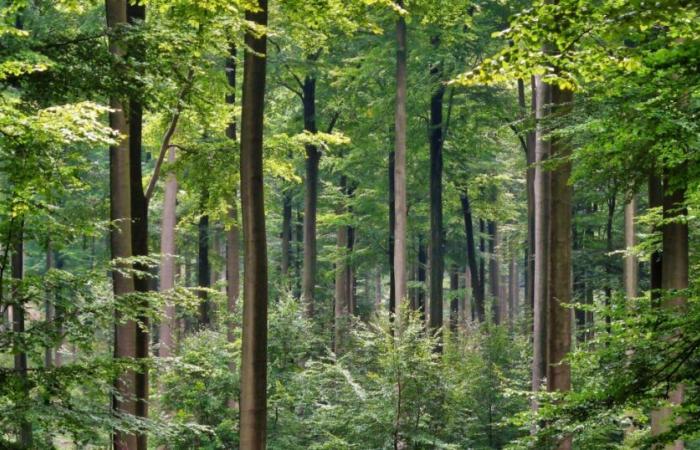Beech or no longer be. Because of climate change, the common beech could disappear from many French forests by 2050. To try to save this species, the National Forestry Office is banking on “assisted migration”, which consists of replanting these trees in regions with a more favorable climate. But the path of foresters is strewn with pitfalls.
From Sainte-Baume in Provence to the tortured hills of Verdun, the beech began a great “assisted migration” thirteen years ago. The Giono project of the National Forestry Office (ONF) hopes to save this species threatened by climate change.
If it is named like this, it is in homage to Jean Giono, the author of The man who planted treesa short story that tells the story of how a solitary shepherd brings a mountain back to life by planting thousands of trees. And also because the writer had fought the battle of Verdun. Since the summer of 2011, remarkable oak acorns and beechnuts have been harvested in Provence, Sarthe, Allier and Deux-Sèvres. And the Meuse was chosen as a host land for its less dry climate and its relatively mild winters. But also because certain local species, such as spruce, are starting to suffer, attacked by bark beetles (our article).
Between the Verdun memorial and the Douaumont ossuary, young shoots emerge from the fog. We can distinguish the beeches by their red autumn color, alongside the shade of green of the surrounding bushes. Raised for two years in a nursery, planted in 2013, the boldest have exceeded three meters. “What is essentialexplains geneticist Brigitte Musch, This is the survival rate. Here we reach more than 90%”while a plantation is considered successful from 80%.
“That worksshe rejoices, her eyes shining. You have to be careful, they are only around ten years old.”they can still “to burst with frost” or be “choked” by a clematis [une plante grimpante à grandes fleurs, NDLR] too invasive. The ONF regularly monitors their growth, health status, resistance to game, etc. The final verdict will come at the end of the 2060s.
The queens of forests soon to be deposed?
But the young deciduous trees have already passed the first tests, taking root in poor, limestone soil, compacted by bombings, which remained full of metal and toxic substances for a long time. “Here, an average of six shells fell per m2. We were in the middle of the front line in 1916. It was so dented that we had to level it with a mechanical shovel to be able to move around”explains Milène Mahut, responsible for forestry at the local ONF agency.
The forest was largely replanted after the First World War: first with conifers – pine seeds were part of the war damages paid by Germany – then with deciduous trees, notably beeches and sessile oaks. This experimental beech plantation, on less than one hectare, is the result of a bet: that of the “migration of genes” of trees, in danger of death in a south that has become too dry, towards the north of the country.
“It all started in 2011 in Manosque”the town of the writer Jean Giono in the Alpes-de-Haute-Provence, during an ONF meeting, remembers Brigitte Musch, initiator of the project and coordinator of forest genetic resources at the Office. This is the time when foresters, who were already observing the decline of the massifs, discovered the climatic analogy method: this makes it possible to aggregate data from UN climate experts and the characteristics of species, to visualize future tree distribution areas on maps.
These maps show how the climate, until now favorable to oak or beech, will work against these queen species of French forests from 2050. It is especially for the common beech that the observation is alarming: this majestic tree, spreading up to at 40 meters its shaded crown and capable of living for several centuries, could disappear from many French regions.
500 years to travel 100 kilometers
The International Union for Conservation of Nature (IUCN), which calls for the use “with caution” assisted migration as a silvicultural management tool, recognizes a situation «difficile». “Oaks or beeches migrate[naturellement, NDLR] of 100 kilometers over a period of more than 500 years”recalls the IUCN. Or ten times slower than the speed at which the climate is changing, judges the ONF.
Author of a thesis on the recolonization of Europe by oak and beech after the last glaciation, some 10,000 years ago, Brigitte Musch draws on her research: “It’s important to see how the tree recolonizes to be able to mimic it. It grows on stones beaten by the wind, brings biodiversity, can be invasive”.
“Faced with climate change, there is no single solution, assisted migration is one”estimates the geneticist. On the plot, Milène Mahut sees the beech growing like “a promise of rebirth”and “hope”for this mistreated land.







